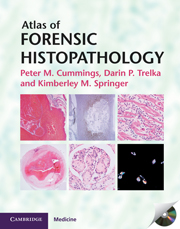7 - Sudden death
Published online by Cambridge University Press: 05 August 2013
Summary
INTRODUCTION
The majority of deaths investigated by forensic pathologists will be certified as natural. The use of appropriate microscopy in these cases will assist the pathologist in identifying the disease process and any other underlying medical condition that may exist. One can logically assume that any “sudden death” is most likely owing to some catastrophic cardiovascular or cerebrovascular event. Most cases of natural death will involve what is known as “sudden cardiac death.” Histologic sampling of the myocardium may reveal an acute infarct or an old scar that may have resulted in dysrhythmia. Histology may also demonstrate hypertensive changes in the vasculature of the kidney or cerebrum, or may reveal stigmata of healing from ischemic injuries in the heart, such as multifocal interstitial fibrosis, in the absence of gross findings. Occasionally the microscopy may corroborate or detect congenital diseases that may have tremendous implications for families, such as idiopathic hypertrophic subaortic stenosis from Anderson–Fabry disease. Deaths related to seizure disorders are also common in forensic practice. Often the examination sheds no light on the eliptogenic origin, but occasionally tumors are discovered or cortical dysplasias may be found. As the population ages, medical care improves and terminal diseases behave more like chronic conditions such that Human Immunodeficiency Virus-related diseases may become more commonplace and may cause the re-interpretation of natural disease states. In this chapter there are numerous photographs of the natural disease processes we commonly encounter.
- Type
- Chapter
- Information
- Atlas of Forensic Histopathology , pp. 92 - 152Publisher: Cambridge University PressPrint publication year: 2000
- 1
- Cited by



